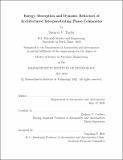Energy Absorption and Dynamic Behaviors of Architectured Interpenetrating Phase Composites
Author(s)
Taylor, Spencer V.
DownloadThesis PDF (47.16Mb)
Advisor
Cordero, Zachary C.
Terms of use
Metadata
Show full item recordAbstract
Novel interpenetrating phase composites show promise for structural aerospace components, but their structure-property relations are not well understood. In this work, we explore the effects of mesoscale geometry on mechanical behaviors of architectured interpenetrating phase composites. We first investigate the tensile behavior of a composite construction termed the chain lattice, which is a hierarchical porous structure comprising two interpenetrating cellular solids. Through tension testing, we demonstrate that combined interphase action results in damage delocalization and an order-of-magnitude improvement in strain-to-failure over the fully dense base material. These experiments validate a micromechanics-based model of tensile specific energy absorption, which we then use in a parametric study on the effects of geometric parameters and matrix properties on tensile behavior. We predict that ceramic chain lattices can achieve an order-of-magnitude improvement in tensile specific energy absorption over the fully dense material. We next examine the macroscale and fine-scale dynamic response of interpenetrating phase composites comprising a body-centered cubic steel lattice embedded in an aluminum matrix. Through plate impact simulations, we find that the complex mesoscale geometry reduces shock velocity relative to monolithic constituents, slowing and spreading the shock front via reflection and redirection. In the fine-scale, we can predict several aspects of the pressure and longitudinal velocity responses by tracking internal wave reflections. Finally, we observe that the post-shock maximum temperature increases with structural openness, and temperature hotspots form at interfaces parallel to the shock direction. The findings in this work 1) highlight the ability to tailor energy absorption of interpenetrating phase composites by controlling mesoscale geometry; and 2) provide novel structure-property linkages in the dynamic response of architectured interpenetrating phase composites.
Date issued
2022-05Department
Massachusetts Institute of Technology. Department of Aeronautics and AstronauticsPublisher
Massachusetts Institute of Technology